2
Overview of Bullying and Victimization
Key Points Made by the Speaker
- A recently developed uniform definition of bullying will help researchers assess the scope and effects of bullying. (Limber)
- Although prevalence rates vary with the timeframe examined, the measurement approach used, the informant, and the geographic location of the study, 20 to 30 percent of children report having been bullied at least once in the past year, and more than 10 percent of children report having been bullied two to three or more times per month in the past 2 months. (Limber)
- Bullying can have harmful effects not only on the targets of bullying but also on children who engage in bullying behaviors, on bystanders, on school climates, and on society at large. (Limber)
- The continued collection of data on bullying will help to indicate whether prevention efforts are helping to change bullying rates. (Limber)
Concerns about bullying have grown dramatically in recent years, noted Susan Limber, the Dan Olweus Distinguished Professor at the Institute on Family and Neighborhood Life at Clemson University, in her introductory
overview of bullying and victimization, but what exactly is “bullying”? Without a consistent definition of bullying, it becomes more difficult to understand the scope and magnitude of the problem, to measure the impact of bullying on children, and to prevent bullying.
After concerns about inconsistent definitions were raised at the first Federal Partners in Bullying Prevention Summit, which took place in 2010, the Centers for Disease Control and Prevention and the U.S. Department of Education launched an initiative to develop a uniform definition of bullying. With input from a panel of researchers and practitioners, the following definition was established (Gladden et al., 2014, p. 7):
Bullying is any unwanted aggressive behavior(s) by another youth or group of youths… that involves an observed or perceived power imbalance and is repeated multiple times or is highly likely to be repeated. Bullying may inflict harm or distress on the targeted youth including physical, psychological, social, or educational harm.
The first key element of this definition, Limber said, is that bullying involves unwanted aggressive behavior—the targeted youth wants the aggression to stop. Bullying does not include playful taunting or teasing, although it can be a challenge for adults and other youth to tell whether behaviors are unwanted or not. The definition also describes aggression as the intentional use of harmful behaviors that are threatened or actual. The focus, Limber explained, is on whether the aggressor intends to use harmful behaviors, not on whether the aggressor intends the target to experience an injury.
The second key element in the definition, Limber said, is that bullying involves an imbalance of power. The aggressor is using observed or perceived personal or situational characteristics to exert control over the target or to limit his or her ability to respond or stop the aggression. Power differences can be characterized by many factors, including physical characteristics such as differences in size, age, or strength, but they can also include such factors as popularity or demographic characteristics, including whether or not a child is a member of a majority or a minority racial or ethnic group. Power differences can also include distinctions in social, academic, or other skills or abilities; access to resources; the ability to reach an entire student body with messages or images sent online; and the power of numbers, Limber said.
A third key element of bullying, she said, is its repetitive quality. Children who are targets of bullying often experience multiple incidents or a pattern of aggressive behavior against them. According to the definition, a single incident can be considered bullying if there is a strong likelihood that it will be followed by more like it. However, even though bullying typically
is repeated over time, a one-time occurrence can be bullying, and adults should not wait for a pattern to emerge before responding, Limber said.
The uniform definition also acknowledges that bullying often inflicts harm or distress on the targeted youth, although this is not a requirement for a behavior to qualify as bullying, Limber noted. Not all bullied youth may be able to immediately identify or express what harm or distress they may have experienced from bullying, she said. For example, a child with developmental delays or disabilities may not always recognize that he or she is being harmed by being taunted or teased, but may be bullied nonetheless, Limber said.
THE CHARACTERISTICS OF BULLYING
The uniform definition document recognizes two distinct modes of bullying, Limber explained. The first is direct bullying, which occurs in the presence of a targeted youth. The second is indirect bullying, such as the spreading of a rumor or encouraging others to exclude a peer.
The uniform definition also enumerates distinct types of bullying. For example, physical bullying includes such acts as hitting, kicking, punching, spitting, tripping, and pushing. Verbal bullying can include taunting, name-calling, sexual comments, or threatening words, notes, or gestures. Relational bullying is designed to harm reputations and relationships through, for example, social isolation, spreading rumors, or posting embarrassing images.
The terms “violence” and “bullying” are sometimes used interchangeably, and bullying is clearly a form of aggressive behavior, Limber said. But while all bullying is aggression, not all aggression is bullying, she observed. For example, a fight or a nasty argument between two peers of equal power or strength certainly is aggressive behavior but probably would not be characterized as bullying.
The World Health Organization has defined violence as “the intentional use of physical force or physical power, threatened or actual, against another person or against a group or community” (Dahlberg and Krug, 2002 p. 5). Thus, it overlaps with bullying but is not synonymous with bullying (see Figure 2-1). Some bullying may constitute discriminatory harassment under federal law. In a “Dear colleague” letter issued in 2010, the U.S. Department of Education’s Office for Civil Rights clarified the relationship between bullying and discriminatory harassment and reminded schools of their obligations under anti-discrimination statutes (U.S. Department of Education, 2010). The letter notes that bullying of an individual based on race, color, national origin, sex, or disability can be a civil rights violation if it is “sufficiently serious that it creates a hostile environment
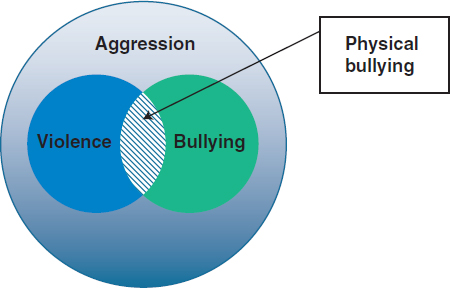
FIGURE 2-1 Physical bullying is a subset of both aggression and the narrower category of violence. SOURCE: Limber presentation, 2014.
and such harassment is encouraged, tolerated, not adequately addressed, or ignored by school employees.”
THE PREVALENCE OF BULLYING
In a review of more than 90 studies that had examined bullying prevalence among children and youth, Cook et al. (2010a) found that the prevalence rates vary according to the timeframe examined, the measurement approached used, the informant, and the geographic location of the study. Were children asked how much bullying they had experienced in the past year, the past 6 months, or the past week? Was bullying defined, and if so, how was it defined? Was the information derived from self-reports, peer reports, or teacher reports? Was bullying being examined in the United States or other countries?
For data on prevalence, Limber cited four national surveys that focus on slightly different age groups. The School Crime Supplement to the National Crime Victimization Survey (NCVS) found that 28 percent of 12- to 18-year-olds said they had been bullied at school in 2011 (Robers et al., 2012). The Youth Risk Behavior Survey (YRBS), which focuses on high school students, reported that in 2011, 20 percent of students had been bullied on school property during the previous year (Eaton et al., 2012).
The Health Behavior in School-Aged Children (HBSC), which collects data from a nationally representative sample of children and youth in grades 5 through 10, reported that during the 2009–2010 school year, 28 percent of youth had been bullied at school at least once in the previous 2 months, while 11 percent of youth had been bullied two to three times per month or more during this timeframe (Iannotti, 2014). The National Survey of Children’s Exposure to Violence, which involved a national telephone survey of caregivers and youth with an age focus from 2 to 17, found that 13 percent of children had been physically bullied and 20 percent had been teased or emotionally bullied during the previous year (Finkelhor et al., 2009).
Researchers interested in examining the prevalence, nature, and effects of bullying often have analyzed the experiences of three distinct groups of children directly involved in bullying, Limber said. The first group consists of youth who bully others but are not themselves bullied. The literature refers to these youth as aggressors, perpetrators, or bullies. The second group consists of youth who are bullied but do not bully others. Sometimes they are referred to as targets or victims. The third group consists of youth who both are bullied themselves and also bully other youth. They often are referred to in the literature as bully–victims.
Cook et al. (2010a) found that children who are bullied constitute the largest proportion of students involved in bullying, followed by youth who bully, and finally youth who are bullied and also bully others. One study of third through twelfth graders who were involved in bullying two to three times per month or more, found these three categories to account for 13 percent (children who are bullied), 4 percent (children who bully others), and 3 percent (children who are bullied and also bully others) of all students in these grades (Limber et al., 2013).
According to data from the HBSC, students in grades 5 through 10 who are bullied two to three times per month or more at school most often experience verbal bullying and the spreading of lies (see Figure 2-2). Similarly, the NCVS found that verbal bullying and rumor spreading were the most common forms of bullying for sixth through twelfth graders (see Figure 2-3).
According to Cook et al. (2010a), boys and girls experience relatively similar rates of being bullied. On the other hand, Limber said, this meta-analysis found that boys were almost twice as likely as girls to bully others and were about 2.5 times as likely to both bully others and be bullied. The prevalence of different types of bullying also differs between boys and girls. According to the NCVS, girls are more likely than boys to indicate that they have been bullied through name-calling, rumor spreading, social exclusion, and cyberbullying, while boys are more likely than girls to say that they have been physically bullied (Eaton et al., 2012).
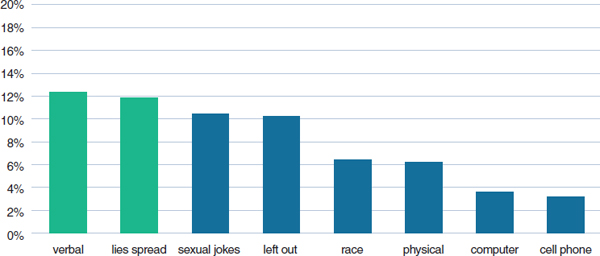
FIGURE 2-2 Prevalence of different types of bullying.
NOTE: The types of bullying that occurred most often are highlighted in green.
SOURCE: Limber presentation, 2014. Data from HBSC, 2013.
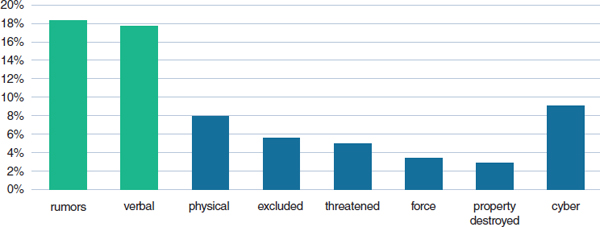
FIGURE 2-3 Students ages 12 through 18 who are bullied during the school year
most often experience rumors and verbal bullying.
NOTE: The types of bullying that occurred most often are highlighted in green.
SOURCE: Limber presentation, 2014. Data from Robers et al., 2013.
Children’s experiences with bullying also vary according to their age, Limber said. The likelihood of being bullied is greatest in elementary and middle school and decreases throughout the high school grades (see Figure 2-4). Similarly, Limber et al. (2013), in a survey of more than 20,000 students in grades 3 through 12, found that rates of being bullied were highest among third graders and thereafter decreased steadily through elementary, middle, and high school both for boys and for girls.
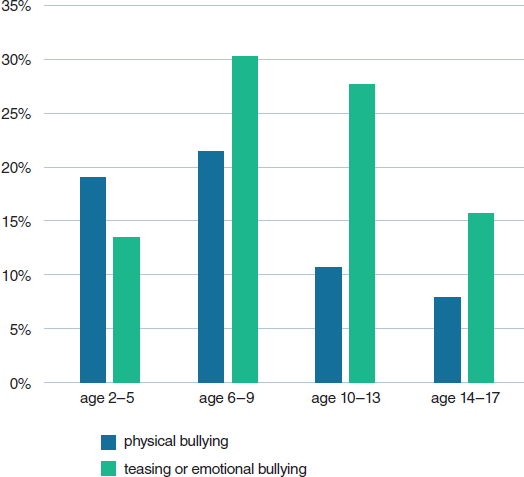
FIGURE 2-4 The likelihood of being bullied is greatest in elementary grades and decreases through middle and high school. SOURCE: Limber presentation, 2014. Data from Finkelhor et al., 2009.
Although bullying victimization is particularly likely in middle childhood, the specific forms of bullying that children are most likely to experience vary by age, depending on the children’s verbal, cognitive, and social development and on circumstances, Limber said. For example, rates of cyberbullying rise from middle school to high school and peak in about the tenth grade (Robers et al., 2013).
Somewhat different age patterns are observed for self-reports of bullying others and of being a bully–victim, Limber said. In a large-scale survey of students in grades 3 through 12, Limber et al. (2013) found that among boys, bullying others increased steadily from about grade 3 through around grade 12, but among girls, rates of bullying others peaked in eighth grade (see Figure 2-5). However, Cook et al. (2010a) found that rates of bullying others decreased from age 3 through age 18 while the likelihood of being a bully–victim peaked in the adolescent years before then decreasing.
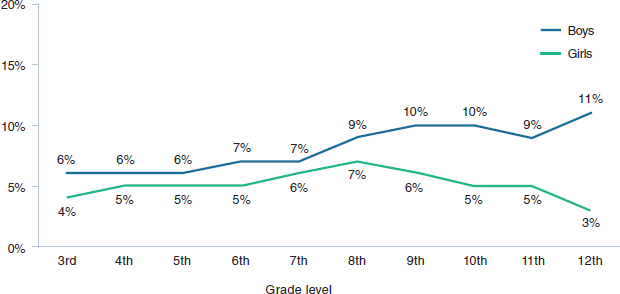
FIGURE 2-5 The percentage of third through twelfth graders who have bullied other students two to three times per month or more rises until eighth grade for boys and girls and continues to rise after that for girls.
SOURCE: Limber et al., 2013.
CHANGES OVER TIME
Despite increased attention to bullying since the early 2000s, the extent to which the rates of bullying have changed over time remains unclear, Limber said. Time trends depend on the data source, the gender of the participants, and the frequency of involvement, she added.
The percentage of students who said they were bullied occasionally—defined as once or more in the past couple of months—decreased between 2001/2002 and 2005/2006 by 16 percent for boys and 15 percent for girls, according to data from the HBSC (Molcho et al., 2009). Frequent victimization decreased by 5 percent for boys and 6 percent for girls during this time period. Data from the NCVS showed that the percentage of 12- to 18-year-olds who said they were bullied at school decreased by about 12 percent between 2007 and 2011, but the trend was much more pronounced for boys than girls (Robers et al., 2010, 2012, 2013). Data from the YRBS, which looks at high school students’ experiences in the previous year, showed no changes between 2009 and 2011, which are the only 2 years for which data are comparable, given changes in the wording of questions over time (Eaton et al., 2009, 2012).
These data need to continue to be gathered and analyzed, Limber emphasized, because they will help to indicate whether bullying prevention efforts are changing the rates of bullying.
THE CONSEQUENCES OF BULLYING
The consequences of bullying include not only the effects on the targets of bullying but also long-term outcomes for children who engage in bullying behavior, effects on bystanders, effects of bullying on the broader school climate, and the costs of bullying to society, Limber said.
Limber added that a very large body of research points to an association between being bullied and later internalizing problems and that a number of recent longitudinal studies have confirmed that being bullied is associated with the later development of a variety of issues: internalizing problems, including depression, anxiety, agoraphobia, panic disorder, and low self-esteem (Copeland et al., 2013; Faris and Felmlee, 2011; Ttofi et al., 2011a); psychosomatic problems, including headaches, stomach pain, sleeping problems, and poor appetite (Gini and Pozzoli, 2013); and school avoidance and lower academic achievement (Buhs et al., 2006, 2010). Some researchers have also found that peer victimization is associated with later externalizing behaviors, such as such as aggression, delinquency, and misconduct (Reijintjes et al., 2010).
Although researchers have concluded that there is a relationship between bullying and suicide-related behaviors (Hertz et al., 2013), relatively few longitudinal studies have been conducted to explore the causal links between bullying and later suicidal ideation, attempts, or deaths by suicide. Researchers have found that being bullied in childhood predicted later suicide attempts and deaths by suicide for girls but not for boys, after controlling for prior depression and conduct problems (Klomek et al., 2013), and that boys identified as bully–victims were at increased risk of suicidal thoughts and attempts in young adulthood (Copeland et al., 2013). However, this connection should not be overstated or misinterpreted, Limber said. The causes of suicide are complex, and many individual, relational, community, and societal factors can contribute to the risk of suicide (CDC, 2012). When researchers used data from the National Violent Death Reporting System to look at the precipitating circumstances for youth ages 10 through 17 who had died by suicide, they found that school-related problems were a precipitating circumstance in about one-quarter of the deaths (Karch et al., 2013). A small percentage of these—12 percent—appear to be related to bullying, Limber said. To put that number in context, she added, intimate-partner relationship problems were identified as a precipitating circumstance in about one-half of the deaths.
Longitudinal research of children who engage in bullying behavior also points to reason for concern, Limber said. For example, research has found that boys who bullied peers in middle school were four times as likely as peers to have three or more criminal convictions as young adults (Olweus, 1993), and boys who frequently bullied others were at high risk for later
criminality when accompanied by a high level of psychiatric symptoms (Sourander et al., 2007). A meta-analysis of 18 studies found that bullying others was related to a greater likelihood of being involved in later criminal behavior and antisocial behavior (Ttofi et al., 2011b). In addition, Espelage et al. (2012) found that bullying others was associated with later sexual harassment of others among middle school students.
By one estimate, more than 80 percent of bullying is witnessed by others (O’Connell et al., 1999), and research suggests that bullying can have significant effects on bystanders (Polanin et al., 2012). Bystanders report feeling anxiety and insecurity (Rigby and Slee, 1993). These feelings stem, in part, from fears of retaliation (Musher-Eizenman et al., 2004), which often prevent bystanders from seeking help (Unnever and Cornell, 2003). Compared with their peers who have not observed bullying, individuals who have report more symptoms of interpersonal sensitivity, helplessness, and potential suicidal ideation (Rivers and Noret, 2013).
Limber reported that many have argued that prevalent bullying or bullying that is not adequately addressed within a school environment can contribute to a negative school climate (Espelage and Swearer, 2010; Olweus, 1993; Olweus et al., 2007), where school climate is defined as the quality and character of school life, including collective beliefs, values, and attitudes (Cohen, 2009; Cohen et al., 2009). Cohen et al. (2009) found that safety, including attitudes about bullying and violence, is one of four essential dimensions of school climate. Students who perceive staff members to be supportive are more likely to indicate they would seek help for bullying and threats of violence (Eliot et al., 2010). In addition, bullying prevention at schools has been associated not only with reductions in bullying but also with improvements in the social climate of the school (Olweus, 1991, 1997).
Finally, Limber said, bullying may result in substantial costs to society. Those who have been involved in bullying are “overconsumers” of society’s health and social services (Olweus, 2012; Sourander et al., 2007), she said. For example, efforts to quantify the costs for troubled youth estimate that the cost of saving a single high-risk youth from a career in crime ranges from $2.6 million to $5.3 million (Cohen and Piquero, 2009; Cohen et al., 2010).
Future research will help to quantify the costs of bullying. But there is no doubt, Limber concluded, that “the individual human price tag is far too costly.”










